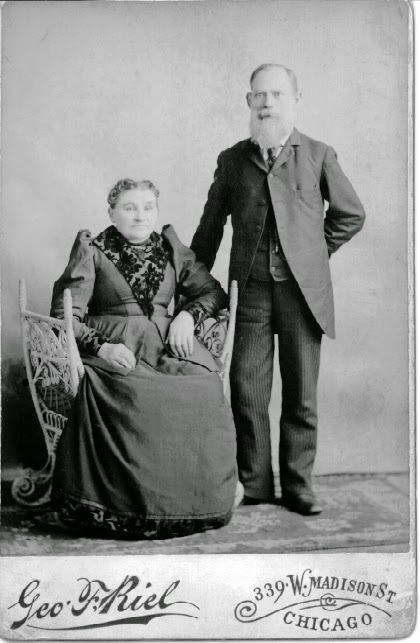As part of the Virtual Institute of Genealogical Studies class, Family Photographs: Identifying, Preserving, and Sharing Your Visual Heritage, our instructor, Maureen Taylor gave us an assignment. We were to select a photo from our personal collection and research the photographer. The report below is the report of my findings. It's not an exhaustive search and some derivative sources were used.
The photograph I selected is of Marie and Andrew Ebling.
Image citation: Andrew and
Marie Ebling portrait, circa 1890s; privately held by C. Fuller, [ADDRESS FOR
PRIVATE USE]; copy provided to M. Goodrum ca. 2000. Fuller inherited the
original from her parents.
Chicago
photographer George F. Riel was born to German immigrants John George
Riel and Pauline Elinor Eber,
in 1856, in Chicago, Illinois.[1] On
21 August 1888, the 32-year-old George F. Riel married Minnie E. Miller. She
was 23.[2]
Sometime between 1904 and 1910, George and his family moved to Fairhope,
Baldwin County, Alabama. Minnie Elizabeth Miller Riel predeceased her
photographer husband. George died in Fairhope, Baldwin County, Alabama on 2
August 1930. His occupation was listed as photographer. His address was Atkinson Lane, Fairhope Alabama.[3]
Below is a listing of the various dates and addresses for
photographer George F. Riel.
Name
|
Year
|
Address-Business/Occupation
|
Address-Residence
|
|
George F. Riel
|
1875-76
1876-77
|
546 Canal
Photographer
|
Listed as “Kiel” in the R section-probably an OCR error.[4]
|
|
George F. Riel
|
1877
|
546 S. Canal
Photographer
|
139 W. 12th
|
Residence also includes John G. Riel, foreman[5]
|
1877-78
1878-79
1 8 7 9 - " "
|
546 Canal
Photographer [6]
|
|||
George Riel
|
1880
|
Photographer
|
139 W. 12th Street
|
Living with parents John J., Paulina, & siblings John &
Paulina[7]
|
George F. Riel
|
1882
|
25 W. 12th
Inspector
|
139 W. 12th
|
Residence includes John G. Riel, laborer[8]
|
George F. Riel
|
1891-1900
|
339 W. Madison
Photographer [9]
|
||
George F. Riel
|
1900
|
Photographer
|
531 Winchester Ave
|
Enumerated with wife Minnie E. and children Ferris T. & Minerva
M.[10]
|
George F. Riel
|
1904
|
339 W. Madison
Photographer[11]
|
||
George F. Riel
|
1910
|
Farmer
|
Baldwin County, Alabama
|
Enumerated with wife Minnie E. and children Ferris T. & Minerva
M.[12]
|
[1] “Alabama Deaths and Burials Index, 1881-1974,” database, Ancestry.com (http://www.ancestry.com : accessed February 26 2015), George Frederick Riel. Also, 1880 U.S.
census, Cook County, Illinois, population schedule, enumeration district (ED)
89, p. 2 (penned), dwelling 5, family 9, George Riel; digital image,
Ancestry.com (http://www.ancestry.com : accessed 26 February 2015), citing
National Archives microfilm publication NARA microfilm publication T9, roll 191.
[2] “Cook County, Illinois, Marriages Index,” database, Ancestry.com
[3] “Alabama Deaths and Burials Index, 1881-1974,” Ancestry.com, George Frederick Riel.
[4] Chicago
Photographers, 1847 through 1900: as listed in Chicago city directories (Chicago:
Chicago Historical Society, 1958); digital image; Hathi Trust Digital Library (http://babel.hathitrust.org : accessed 28 February 2015).
[5] Thomas Hutchinson, compiler, The Lakeside Annual Directory of the City of Chicago, (1877-8), p. 833; digital image, Ancestry.com (http://www.ancestry.com : accessed 26
February 2015).
[7] 1880 U.S. census, Cook Co., Ill., pop. sched., ED 89, p. 2 (penned), dwell. 5, fam. 9, George Riel.
[8]
[10] 1900 U.S. census, Cook County, Illinois, population
schedule, Chicago, ED 249, sheet 10-49, dwelling 74, family 209, George F. Riel;
digital image, Ancestry.com (http://www.ancestry.com : accessed 26 February
2015); citing National Archives microfilm publication T623, roll 254.
[11] Business Directory of Chicago (1904), p. 734; digital image, Ancestry.com (http://www.ancestry.com : accessed 26 February 2015).
[12] 1910 U.S. census, Baldwin County, Alabama, population
schedule, Precinct 10 Fairhope and Zundeli, ED 9, sheet 8B, dwelling 184,
family 190, George F. Riel; digital image, Ancestry.com (http://www.ancestry.com
: accessed 26 February 2015); citing National Archives microfilm publication
T624, roll 1.
[13]
To cite this post:
Michelle Goodrum, "George F. Riel, Chicago Photographer," The Turning of Generations, 27 February 2015 (http://turning-of-generations.blogspot.com/2015/02/george-f-riel-chicago-photographer.html : [access date].
© 2015, copyright Michelle Goodrum
